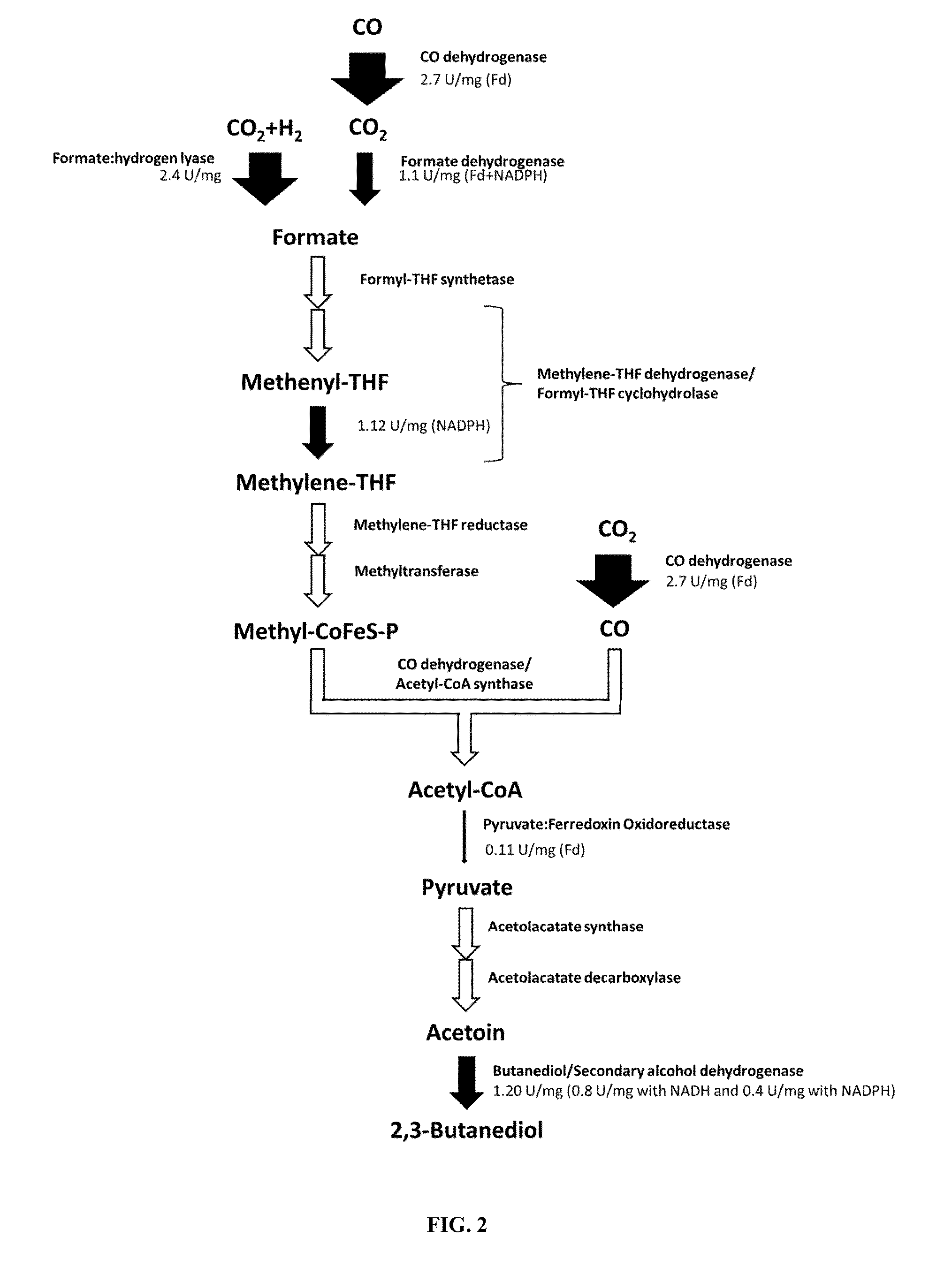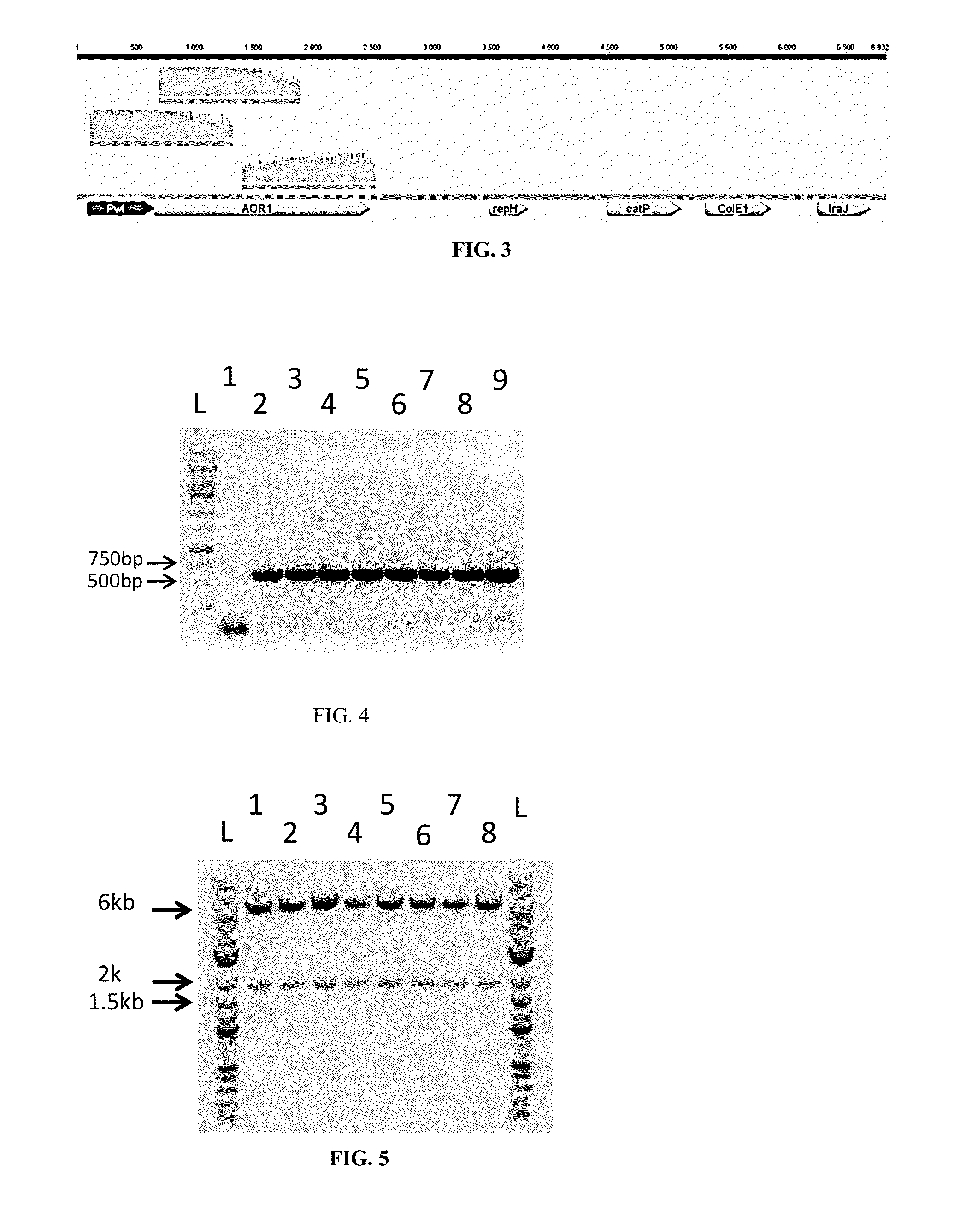Recombinant microorganisms exhibiting increased flux through a fermentation pathway
a technology of recombinant microorganisms and fermentation pathways, which is applied in the direction of biofuels, enzymology, transferases, etc., can solve the problems of bottling, rate and titer, and the metabolism of natural organisms that did not evolve to achieve commercial objectives of high yield, and achieves the effect of increasing activity or increasing availability
- Summary
- Abstract
- Description
- Claims
- Application Information
AI Technical Summary
Benefits of technology
Problems solved by technology
Method used
Image
Examples
example 1
Identification of Bottlenecks
[0182]Fermentation pathways of carboxydotrophic bacteria such as C. autoethanogenum, C. ljungdahlii, or C. ragsdalei for production of ethanol and 2,3-butanediol were analyzed for bottlenecks using enzyme assays. For this, oxidoreductase reactions are particularly suitable, as they are coupled with one or more co-factors whose reduction or oxidation can be measured. A synthetic redox dye such as methylviologen or benzylviologen can be used for this purpose as well.
[0183]Oxidoreductase enzyme steps of the Wood-Ljungdahl pathway and fermentation pathways to ethanol and 2,3-butanediol were assayed to determine their activity. The enzymes in these pathways are involved in autotrophic growth including uptake and utilization of CO, CO2, and H2 gases as well as product formation.
[0184]The enzymes assayed and their activities are detailed in FIG. 1. All assays performed were tested using a synthetic redox dye as control, either methyl viologen (MV) or benzyl vio...
example 2
Bottleneck for Ethanol Production
[0199]As seen in the ethanol fermentation pathway depicted in FIG. 1, the bottleneck for ethanol production is the alcohol dehydrogenase reaction. While all other measured reactions showed at least an activity of 1.1 U / mg, the alcohol dehydrogenase reaction step has only a total activity of 0.35 U / mg (or 31%), 0.2 U / mg (18%) with NADH and 0.15 U / mg (13%) with NADPH. This is 69% less than all other reactions in the pathway. In a similar fashion, the aldehyde dehydrogenase reaction had only a total activity of 0.16 U / mg (14%), 0.08 U / mg (7%) with NADH and 0.08 U / mg (7%) with NADPH. This is 86% less than all other reactions in the pathway. This reaction however can be bypassed via acetate and the aldehyde:ferredoxin oxidoreductase (AOR) which has an activity of 1.9 U / mg and has the advantage of yielding ATP through substrate level phosphorylation in the acetate kinase reaction thus providing more energy to the cell. To go at least some way towards overc...
example 3
Increasing the Flux Through an Ethanol Production Pathway by Removing Bottlenecks
[0200]The reactions catalysing the conversion of acetyl-coA to acetaldehyde and from acetaldehyde to ethanol have been identified to be the rate limiting steps in ethanol formation in C. autoethanogenum, C. ljungdahlii, or C. ragsdalei. This can be overcome by either
i. overexpressing the native bifunctional alcohol / aldehyde dehydrogenase,
ii. expressing a heterologous bifunctional alcohol / aldehyde dehydrogenase, or
iii. expressing a heterologous aldehyde dehydrogenase and an alcohol dehydrogenase.
These outcomes can be achieved by using the methods described below.
Overexpressing the Native Bifunctional Alcohol / Aldehyde Dehydrogenase in C. autoethanogenum
[0201]It was chosen to overexpress the native bifunctional alcohol / aldehyde dehydrogenase gene of C. autoethanogenum (Sequence ID: 1) and express a heterologous bifunctional alcohol / aldehyde dehydrogenase gene of C. acetobutylicum (Genbank nucleic acid ID:...
PUM
| Property | Measurement | Unit |
|---|---|---|
| Efficiency | aaaaa | aaaaa |
Abstract
Description
Claims
Application Information
 Login to View More
Login to View More - R&D
- Intellectual Property
- Life Sciences
- Materials
- Tech Scout
- Unparalleled Data Quality
- Higher Quality Content
- 60% Fewer Hallucinations
Browse by: Latest US Patents, China's latest patents, Technical Efficacy Thesaurus, Application Domain, Technology Topic, Popular Technical Reports.
© 2025 PatSnap. All rights reserved.Legal|Privacy policy|Modern Slavery Act Transparency Statement|Sitemap|About US| Contact US: help@patsnap.com



